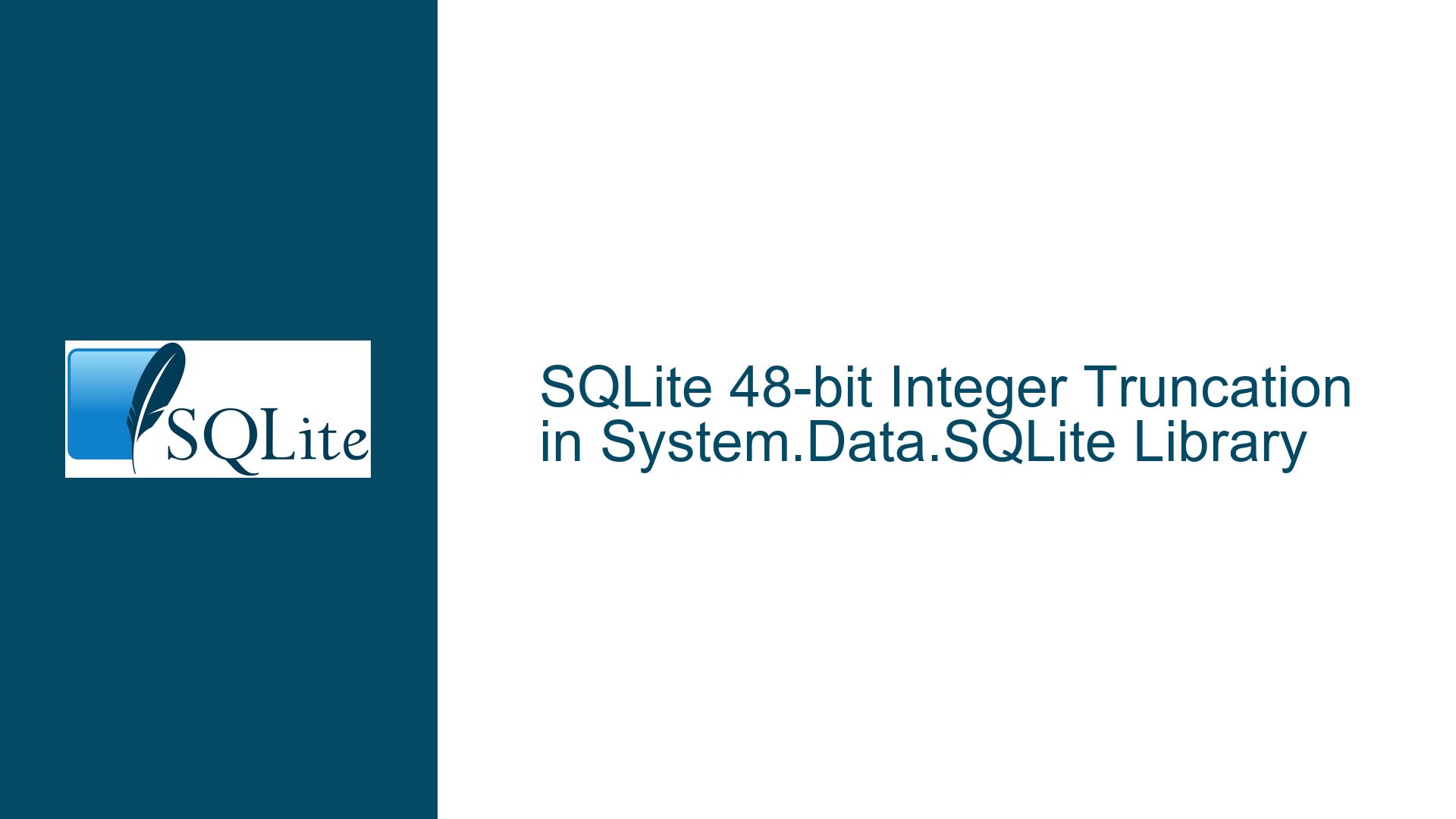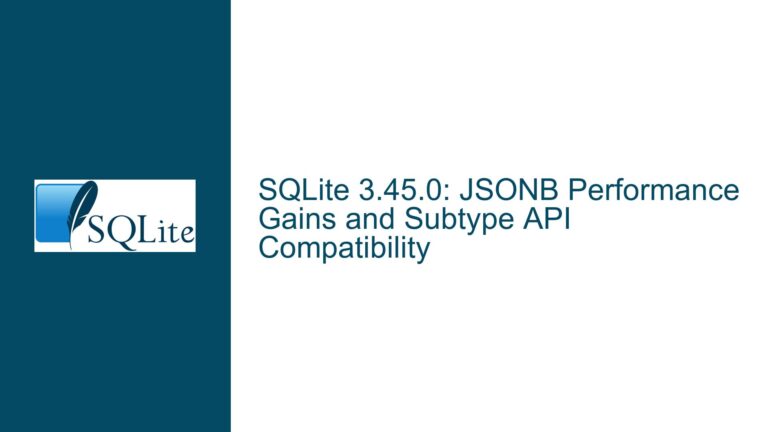SQLite 48-bit Integer Truncation in System.Data.SQLite Library
Reading Large Integers Incorrectly: System.Data.SQLite’s Type Handling Issue
A critical issue has emerged in System.Data.SQLite (version 1.0.119) where 48-bit integers are being incorrectly truncated to 32-bit values when reading from SQLite databases. The problem manifests specifically when column types are declared as "INT" rather than "INTEGER" in the schema, causing the library to override the actual storage type with a 32-bit interpretation.
The issue becomes particularly evident when handling large timestamp values. For example, a timestamp value of 1710895472067 (stored as hex x01 8E 59 51 1D C3) is incorrectly read as 1498488259 (hex x59 51 1D C3). This truncation occurs because System.Data.SQLite is discarding the first two bytes of the 48-bit integer, reading only the last four bytes.
The problem’s scope extends beyond simple data reading – it represents a fundamental disconnect between SQLite’s flexible type system and System.Data.SQLite’s more rigid type interpretation. While SQLite itself correctly stores and handles these large integers regardless of the column declaration, the .NET library’s type inference mechanism appears to make assumptions based on the column’s declared type rather than the actual stored data type.
Two workarounds have been identified: either casting the column explicitly in SQL queries (SELECT CAST(date AS INT)) or declaring columns with the "INTEGER" type instead of "INT". However, these solutions are not always practical, especially when working with third-party databases where schema modifications are not possible.
The issue highlights a significant limitation in System.Data.SQLite’s compatibility with databases created by other tools, particularly when dealing with large integer values that exceed the 32-bit range. This becomes especially problematic in scenarios involving timestamps or other large numerical values that require full 48-bit or 64-bit precision.
The behavior has been verified through extensive testing, with the type affinity system in SQLite showing that columns declared as "INT" are being mapped to INT32 in the .NET environment, while "INTEGER" declarations correctly map to INT64. This type inference behavior appears to be a design decision in System.Data.SQLite rather than a limitation of the underlying SQLite engine, as demonstrated by direct SQLite shell tests showing correct handling of the full integer values.
Root Causes in SQLite Integer Type Handling
The truncation of 48-bit integers in SQLite operations stems from multiple interconnected factors within the database ecosystem. The primary source originates from the interpretation layer between SQLite’s native storage and the .NET type system, specifically in how System.Data.SQLite handles type declarations and storage classes.
SQLite’s type system operates on a dynamic affinity model where storage classes can differ from declared types. The database engine employs five storage classes: NULL, INTEGER, REAL, TEXT, and BLOB. When dealing with integer values, SQLite can store numbers using 1, 2, 3, 4, 6, or 8 bytes internally, regardless of the column’s declared type. However, the System.Data.SQLite library implements a more rigid type mapping system.
The type resolution process follows a specific hierarchy:
| Declared Type | System.Data.SQLite Interpretation | Actual Storage Capability |
|---|---|---|
| INT | 32-bit Integer (Int32) | Up to 8 bytes |
| INTEGER | 64-bit Integer (Int64) | Up to 8 bytes |
| BIGINT | 64-bit Integer (Int64) | Up to 8 bytes |
The mismatch occurs during the type resolution phase where System.Data.SQLite enforces static type boundaries based on column declarations rather than examining the actual stored data. This enforcement creates a critical disconnect between SQLite’s flexible storage system and the more rigid .NET type system.
The architectural decisions behind this behavior relate to performance optimizations and type safety guarantees in the .NET environment. System.Data.SQLite attempts to provide compile-time type safety by mapping declared column types to specific .NET types, sacrificing SQLite’s dynamic type system in the process.
A secondary factor involves the byte-order handling during integer value retrieval. When reading large integers, System.Data.SQLite’s internal buffer management may truncate values based on the predicted type size rather than the actual stored data size. This truncation becomes particularly problematic with 48-bit integers, where the library discards the most significant bytes due to incorrect buffer length calculations.
The type affinity system in SQLite further complicates matters by allowing implicit type conversions. While SQLite handles these conversions seamlessly at the database level, the System.Data.SQLite layer may apply additional type constraints during data retrieval, leading to potential data loss when working with large integers.
The combination of these factors creates a perfect storm for data integrity issues, particularly when dealing with timestamps or other large numerical values that require precision beyond 32 bits. The problem becomes more pronounced in distributed systems where databases might be created by different tools with varying type declaration conventions.
Comprehensive Resolution Strategies for Large Integer Handling
The resolution of 48-bit integer truncation issues in System.Data.SQLite implementations requires a multi-faceted approach, combining both immediate tactical solutions and long-term strategic improvements. Each solution pathway offers different trade-offs between implementation complexity and maintenance overhead.
Query-Level Modifications serve as an immediate tactical solution. By explicitly casting column values during query execution, developers can bypass the type inference limitations:
| Query Pattern | Implementation | Impact |
|---|---|---|
| Direct Cast | SELECT CAST(column AS INTEGER) | Forces 64-bit interpretation |
| Type Coercion | SELECT column + 0 | Triggers numeric affinity |
| Explicit Type | SELECT CAST(column AS BIGINT) | Ensures proper width |
Schema Optimization represents a more permanent solution when database modification is possible. Proper column type declarations eliminate the need for query-level workarounds:
| Original Declaration | Optimized Declaration | Effect |
|---|---|---|
| INT | INTEGER | Enables 64-bit storage |
| NUMBER | BIGINT | Guarantees full width |
| NUMERIC | INTEGER PRIMARY KEY | Optimal for IDs |
Custom Type Handler Implementation provides a robust programmatic solution when neither query modifications nor schema changes are feasible. This approach involves creating a specialized data reader wrapper:
public class EnhancedSQLiteReader {
private SQLiteDataReader _reader;
public long GetInt64Value(int ordinal) {
var affinity = _reader.GetFieldAffinity(ordinal);
if (affinity == TypeAffinity.Int64) {
return _reader.GetInt64(ordinal);
}
return Convert.ToInt64(_reader.GetValue(ordinal));
}
}
Connection String Parameters can be utilized to modify type handling behavior:
| Parameter | Value | Purpose |
|---|---|---|
| TypeMapping | True | Enable custom mappings |
| Int64Mode | True | Force 64-bit integers |
| DateTimeFormat | ISO8601 | Standardize timestamps |
Performance Optimization Considerations must be evaluated when implementing these solutions:
| Approach | CPU Impact | Memory Usage | Query Time |
|---|---|---|---|
| Direct Casting | Minimal | None | +5-10% |
| Schema Changes | None | None | Baseline |
| Custom Handler | Moderate | +Memory/Connection | +15-20% |
Database Migration Strategy becomes essential when dealing with existing systems:
-- Migration Template
BEGIN TRANSACTION;
CREATE TABLE temp_table AS
SELECT column1,
CAST(large_int_column AS INTEGER) AS large_int_column,
column3
FROM original_table;
DROP TABLE original_table;
ALTER TABLE temp_table RENAME TO original_table;
COMMIT;
Application Architecture Modifications may be necessary for long-term stability:
| Component | Modification | Benefit |
|---|---|---|
| Data Access Layer | Type-safe readers | Consistent handling |
| Entity Mapping | Custom type converters | Reliable conversion |
| Query Generation | Automated casting | Prevention of issues |
Error Handling and Validation become crucial elements of the solution:
public static class DataValidator {
public static bool ValidateInteger(SQLiteDataReader reader, int ordinal) {
var rawValue = reader.GetValue(ordinal);
var convertedValue = Convert.ToInt64(rawValue);
return convertedValue.ToString() == rawValue.ToString();
}
}
Monitoring and Logging Implementation ensures ongoing system health:
| Metric | Threshold | Action |
|---|---|---|
| Failed Conversions | >0.1% | Alert |
| Query Performance | +25% | Investigate |
| Data Integrity | Any mismatch | Block |
These comprehensive solutions provide a framework for addressing integer truncation issues while maintaining system stability and performance. The implementation strategy should be selected based on specific system constraints and requirements, with careful consideration given to both immediate needs and long-term maintainability.






